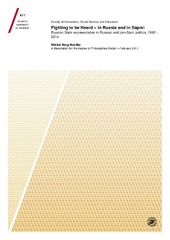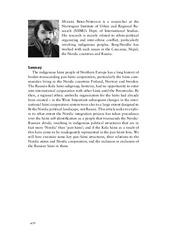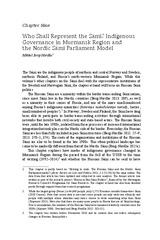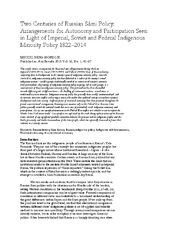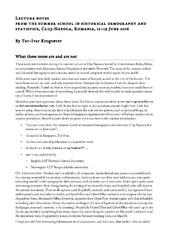| dc.contributor.advisor | Tjelmeland, Hallvard | |
| dc.contributor.author | Berg-Nordlie, Mikkel | |
| dc.date.accessioned | 2017-09-04T13:07:35Z | |
| dc.date.available | 2017-09-04T13:07:35Z | |
| dc.date.issued | 2017-09-15 | |
| dc.description.abstract | This thesis constitutes a study of Russian Sámi representation in Russian and pan-Sámi politics during the period 1992-2014. It contributes to the study of Sámi political history by exploring the systems for Russian Sámi representation that have been established and disestablished during the period under analysis, and the conflicts that have taken place over the organization of Russian Sámi representation. The thesis takes an interest in analysing the degree of representativeness inherent in various models for Russian Sámi representation, and the effect of pan-Sámi networking on Russian Sámi politics. By addressing this task, the thesis furthermore serves the function of accounting for the background, establishment, and conflicts surrounding the movement for a Russian Sámi Parliament that appeared during the period under analysis. The thesis is article-based, consisting of four articles and an introductory/summary section.
<br>INTRODUCTORY/SUMMARY SECTION: The introductory/summary section begins with an introduction of the subject of study, clarifies some key categories and concepts, and introduces the concretized research questions: “Which mechanisms for Russian Sámi representation on the Russian arena and pan-Sámi arena were established and discontinued 1992-2014, and how representative can these be considered as having been?” and “What were the main changes and continuities in Russian Sámi representation 1992-2014 and how can these be explained? How were developments in Russian Sámi representation in Russia affected by Russian Sámi participation in pan-Sámi networks?”. The ensuing chapters address issues of historiography, theory, methodology, and ethics, and briefly presents the individual thesis articles. Following this, the thesis summarizes findings from the articles in the form of a chronological narrative, that also incorporates data and analysis not present in the articles. Historical background to the period 1992-2014 is presented, as is necessary context information about general developments in Russian politics and Nordic Sámi discourses during the period under analysis. Subsequently, developments in structures for Russian Sámi representation at the pan-Sámi and Russian level 1992-2014 are accounted for, and said structures’ degrees of representativeness are given comment. The period 1992-2006 sees the full and equal integration of the Russian Sámi into the Sámi Council (from 1992) and the Barents WGIP (est. 1993), their phasing out from the Nordic Sámi Convention process during the 1990s, and their less than equal inclusion in the Sámi Parliamentary Council (est. 2000). In Murmansk Region, the same period is characterized by weak institutionalization of indigenous governance and an absence of formalized representation structures for the Sámi. Two initiatives for the establishment of a Russian Sámediggi occur during this period. Following this, developments 2006-2014 are covered. This period sees the establishment of three official councils for Sámi representation in Russia: the Coordination Council (2006-08), the Council of Representatives (2009 - ), and the Sám’ Sobbar (2014 - ). Simultaneously, the first movement for a Russian Sámi Parliament movement emerges in 2007, uniting some actors in Russian Sámi civil society and dividing others. In the period, two councils are created through support of this movement: SUPS (2008-2010) and Kuèllnègk njoark sám’ sobbar (2010), the latter being referred to by the movement as a Russian Sámi Parliament. The thesis accounts for how the Kuèllnègk njoark sám’ sobbar seeks recognition both at the pan-Sámi level and in Murmansk Region, and the effects of this. Finally, the introductory/summary section presents events in 2014 and effects of these that were not covered in the thesis articles. The section concludes with a discussion on change and continuity, and the effect of pan-Sámi networking on Russian Sámi representation.
<br>
THESIS ARTICLES: Article I “Need and Misery in the Eastern Periphery: Nordic Sámi Media Debate on the Kola Sámi” (2011) critically discusses Nordic Sámi media discourses on the Russian Sámi, 1992-2009. Article II “The Iron Curtain through Sápmi. Pan-Sámi Politics, Nordic Cooperation and the Russian Sámi” (2013) investigates the degree of equal representation given to the Russian Sámi in central pan-Sámi projects and structures. Article III “Who Shall Represent the Sámi? Indigenous Governance in Murmansk Region and the Nordic Sámi Parliament Model” (2015) accounts for the development of structures for indigenous governance and representation established by Murmansk Region 1992-2014, and the Russian Sámi Parliament movement. Article IV “Two Centuries of Russian Sámi Policy. Arrangements for Autonomy and Participation Seen in Light of Imperial, Soviet and Federal Indigenous Minority Policy 1822–2014” (2015) accounts for long lines in Russian indigenous policy, going beyond the thesis’ period of analysis 1992-2014 and discussing the historical experiences of the Russian Sámi in light of these. | en_US |
| dc.description.doctoraltype | ph.d. | en_US |
| dc.description.popularabstract | This thesis constitutes a study of Russian Sámi representation in Russian and pan-Sámi politics during the period 1992-2014. It contributes to the study of Sámi political history by exploring the systems for Russian Sámi representation that have been established and disestablished during the period under analysis, and the conflicts that have taken place over the organization of Russian Sámi representation. The thesis takes an interest in analysing the degree of representativeness inherent in various models for Russian Sámi representation, and the effect of pan-Sámi networking on Russian Sámi politics. By addressing this task, the thesis furthermore serves the function of accounting for the background, establishment, and conflicts surrounding the movement for a Russian Sámi Parliament that appeared during the period under analysis.
The thesis is article-based, consisting of four articles and an introductory/summary section. | en_US |
| dc.description.sponsorship | Norwegian Resource Council, Programme for Sámi Studies.
Norwegian Resource Council, NORRUSS.
NIBR Institute of Oslo and Akershus University College.
UiT Arctic Universtiy of Norway. | en_US |
| dc.identifier.uri | https://hdl.handle.net/10037/11405 | |
| dc.language.iso | eng | en_US |
| dc.publisher | UiT Norges arktiske universitet | en_US |
| dc.publisher | UiT The Arctic University of Norway | en_US |
| dc.rights.accessRights | openAccess | en_US |
| dc.rights.holder | Copyright 2017 The Author(s) | |
| dc.rights.uri | https://creativecommons.org/licenses/by-nc-sa/3.0 | en_US |
| dc.rights | Attribution-NonCommercial-ShareAlike 3.0 Unported (CC BY-NC-SA 3.0) | en_US |
| dc.subject | VDP::Humanities: 000::History: 070::Political history: 071 | en_US |
| dc.subject | VDP::Humaniora: 000::Historie: 070::Politisk historie: 071 | en_US |
| dc.subject | VDP::Humanities: 000::History: 070::Contemporary history (after 1945): 084 | en_US |
| dc.subject | VDP::Humaniora: 000::Historie: 070::Samtidshistorie (etter 1945): 084 | en_US |
| dc.title | Fighting to be Heard – in Russia and in Sápmi. Russian Sámi representation in Russian and pan-Sámi politics, 1992 -2014 | en_US |
| dc.type | Doctoral thesis | en_US |
| dc.type | Doktorgradsavhandling | en_US |


 English
English norsk
norsk